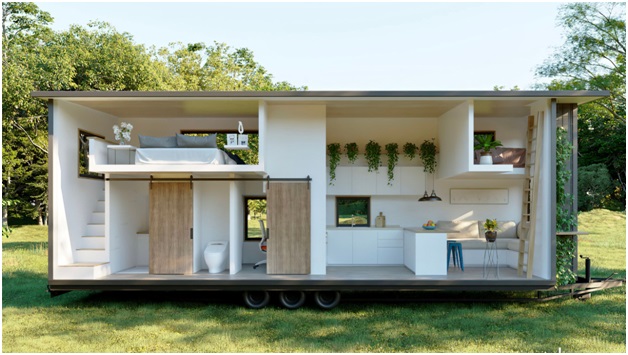In recent years, a quiet revolution has been taking place in the world of housing – the rise of tiny house living. People are increasingly drawn to the idea of simplifying their lives, reducing their environmental footprint, and embracing a minimalist lifestyle. The concept of tiny houses, typically ranging from 100 to 400 square feet, has captured the imagination of individuals seeking a more sustainable and affordable way of living. In this blog post, we’ll delve into the growing trend of tiny house living, offering insights into designing and building these compact dwellings, while also exploring the unique challenges and benefits associated with this lifestyle.
Designing a Tiny House: Maximizing Space and Functionality
1. Prioritize Multifunctional Furniture:
In the confined space of a tiny house, every square inch counts. Opt for furniture that serves multiple purposes, such as a sofa that can transform into a bed or a dining table that doubles as a work desk. This approach allows you to make the most of limited space without sacrificing functionality.
2. Embrace Vertical Space:
Utilize vertical space to create the illusion of a larger area. Incorporate tall bookshelves, storage cabinets, and lofted sleeping areas to maximize the use of vertical real estate. This not only adds storage but also contributes to an open and airy feel within the tiny space.
3. Choose Light Colors and Natural Light:
Light colors and ample natural light can make a tiny house feel more spacious. Opt for light-colored walls and furnishings to create a bright and open atmosphere. Additionally, strategically placed windows and skylights can enhance the perception of space while providing ventilation. There are best home interior designer in Liverpool who can help you in choosing light colors of your home
4. Incorporate Outdoor Living Spaces:
Extend your living space to the outdoors by creating a functional and inviting outdoor area. Whether it’s a small deck, patio, or rooftop garden, having an outdoor retreat can compensate for the limited interior space and create a seamless connection with nature.
Building a Tiny House: Tips for a Successful Project
1. Know Your Local Zoning Laws:
Before embarking on your tiny house journey, familiarize yourself with local zoning laws and building codes. Some areas have strict regulations regarding the minimum size of dwellings, and it’s crucial to ensure your tiny house complies with these rules to avoid legal issues.
2. Consider a Trailer Foundation:
Many tiny houses are built on trailers, allowing for mobility and flexibility. If you’re open to a mobile lifestyle, consider constructing your tiny house on a trailer foundation. This also circumvents some of the zoning restrictions that may apply to permanent structures.
3. Focus on Quality Materials:
Given the limited space, it’s essential to use high-quality materials that are durable and space-efficient. Choose materials that are both lightweight and sturdy, and consider eco-friendly options to align with the sustainable ethos often associated with tiny house living. Specially focus on your gutter pipes of your house. If you need quality gutter pipes related services then gutter cleaning Sheffield is the best option for you.
4. Optimize Energy Efficiency:
Tiny houses provide an excellent opportunity to embrace energy-efficient practices. Invest in well-insulated walls, windows, and doors to reduce energy consumption. Consider alternative energy sources such as solar panels to make your tiny house more sustainable and cost-effective in the long run.
Challenges of Tiny House Living: Addressing the Downsides
1. Limited Storage Space:
One of the primary challenges of living in a tiny house is the limited storage space. Downsizing belongings and adopting minimalist habits become essential. Consider creative storage solutions, such as built-in cabinets, under-bed storage, and wall-mounted racks.
2. Zoning and Legal Issues:
Navigating zoning laws and legal restrictions can be a significant hurdle. Some areas have strict regulations that may make it challenging to legally park or live in a tiny house. Thorough research and consultation with local authorities are crucial to addressing these challenges.
3. Adjustment to Minimalist Living:
The transition to tiny house living often requires a shift in mindset. Adjusting to a more minimalist lifestyle may be challenging for those accustomed to larger spaces and possessions. However, many find the simplicity and intentional living associated with tiny houses to be rewarding in the long run.
Benefits of Tiny House Living: Embracing a Simpler Lifestyle
1. Financial Freedom:
Tiny houses are often more affordable to build and maintain than traditional homes. This financial freedom allows individuals to reduce or eliminate mortgage debt, freeing up resources for other experiences and pursuits.
2. Environmental Impact:
Tiny houses have a significantly smaller environmental footprint compared to larger homes. With reduced energy consumption, lower construction materials, and the potential for off-grid living, tiny house dwellers can contribute to a more sustainable way of life.
3. Mobility and Flexibility:
For those with a sense of adventure, the mobility of tiny houses is a significant advantage. Whether it’s relocating for a job opportunity or simply changing your surroundings, the ability to hitch your home to a trailer offers a unique form of flexibility.
4. Simplified Maintenance:
Smaller living spaces translate to less cleaning and maintenance. Tiny house dwellers often find that they spend less time and effort on household chores, allowing for more free time to pursue hobbies and experiences.
In conclusion, the growing trend of tiny house living is a testament to the evolving preferences of individuals seeking a simpler, more intentional lifestyle. Designing and building a tiny house require thoughtful consideration and creativity to make the most of limited space. While challenges exist, the benefits, including financial freedom, reduced environmental impact, and a simplified lifestyle, can be incredibly rewarding for those who embrace this unique way of living. Whether you’re considering downsizing, adopting a more sustainable lifestyle, or simply curious about the tiny house movement, exploring this trend opens a door to a world where less truly becomes more.
